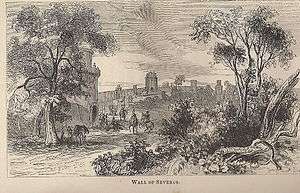Wall of Severus

The Wall of Severus is believed to be a defensive fortification built by the Roman Emperor Septimius Severus (reigned AD 193–211) during his military campaigns in northern Britannia in the early 3rd century.[1] Although the structure is mentioned in several classical texts, its precise locations is academically disputed due to inconsistencies between sources. Scholarly consensus believes they are most likely referring to the Antonine Wall. However, Hadrian's Wall and Offa's Dyke have both been suggested as possible candidates. Archaeological evidence has been discovered showing parts of Offa's Dyke, on the England-Wales border, is at least as old as the mid-5th century predating the 8th-century reign of the Saxon King Offa of Mercia by 300 years.[2]
Historiography
Septimius Severus arrived in Caledonia in 208 after Picts began making a series of attacks and incursions since 197. During these military operations in Scotland, the Wall of Severus was reportedly built. Cassius Dio, a Roman historian who lived at the time of Severus, makes no direct mention to any new fortification but does allude to the existing Antonine and Hadrian Walls.[3] Late Roman historians interchange the name Severan Wall with the Antonine Wall. Other historical writers like Bede - an 8th-century English monk in the Angle Kingdom of Northumbria, link the fortification with Hadrian's Wall.[4]
Texts that refer to the wall include:
- Eutropius (late 4th century) writes: "He had his last war in Britain, and to fortify the conquered provinces with all security, he built a wall for 132 miles from sea to sea. He died at York, a reasonably old man, in the sixteenth year and third month of his reign." (Eutropius, Historiae Romanae Breviarium viii 19.1, written in AD 369).
- Historia Augusta (probably late 4th century), within the Life of Severus, mentions: "He built a wall across the island of Britain from sea to sea, and thus made the province secure — the crowning glory of his reign; in recognition thereof he was given the name Britannicus." (Historia Augusta, Life of Severus, 18:2, written around AD 395).
- Bede (8th century) writes: "In the year of our lord 189 (AD), Severus became emperior (of Rome)... being of a harsh disposition and engaged in many wars, he governed the state vigorously, but with much trouble, having been victorious in all the grievous civil wars that occurred in his time, he was drawn into Britain by a revolt of almost all the confederated tribes, and after many great an severe battles,he thought fit to divide that part of the island that he recovered from the other unconquered nations, not with a wall as some have imagined but with a rampart, for a wall is made of stones. A rampart for which camps are fortified to repel enemies is made of sods cut out of the ground and raised high above the ground like a wall, having in front of it a trench from whence the sods were taken, with strong stakes of wood afitted above it. Thus severus drew a great trench and rampart fortified with several towers from sea to sea, and there at York afterwards he fell sick and died."[5]
- Asser (9th century), writing in The Life of King Alfred: " The wall was a good defense as long as Roman soldiers remained to guard it. But in process of time—about two centuries after Severus's day—the Roman empire itself began to decline, even in the very seat and center of its power; and then, to preserve their own capital from destruction, the government were obliged to call their distant armies home."
- William of Malmesbury's Chronicle of the Kings of England (early 12th century), a translation of William of Malmesbury's Gesta regum Anglorum, and a reading of the original Latin both assert: "Severus and Constantius, two of their greatest princes, died upon the island, and were there interred with the utmost pomp. The former, to defend this province from the incursions of the barbarians, built his celebrated and well-known wall from sea to sea." (Chapter 1/Cap I) AD1096/IC CVI
Existence
As the location of the wall remains undetermined, its existence was academically questioned in the early 20th century because there is no evidence that Severus built any fortifications during his time in Britain.[6] Current academic consensus believes that Severus' campaigns involved repairing and strengthening the abandoned Antonine Wall before falling back to Hadrian's Wall.[7]
Notes
- ↑ Elliott, Simon; Hughes, Tristan (18 March 2018). "The Scottish Campaigns of Septimius Severus". Turning Points Of The Ancient World. Retrieved 21 May 2018.
- ↑ "The 'Wall of Severus'". Retrieved 18 September 2016.
- ↑ "THE CALEDONIAN CAMPAIGNS OF SEPTIMIUS SEVERUS". www.dot-domesday.me.uk. Retrieved 9 January 2018.
- ↑ Bede (1843). John Allen Giles, ed. The Complete Works of Venerable Bede. London: Whittaker and Company. p. 43.
- ↑ Bede. "Chapter 4". Ecclesiastical History of England. I.
- ↑ Collingwood, R. G. (1923). "The British Frontier in the Age of Severus". The Journal of Roman Studies. 13: 69–81.
- ↑ "The Scottish campaigns of Septimius Severus 208 - 211" (PDF). Faculty of Archaeology, University of Leiden. Retrieved 9 January 2018.